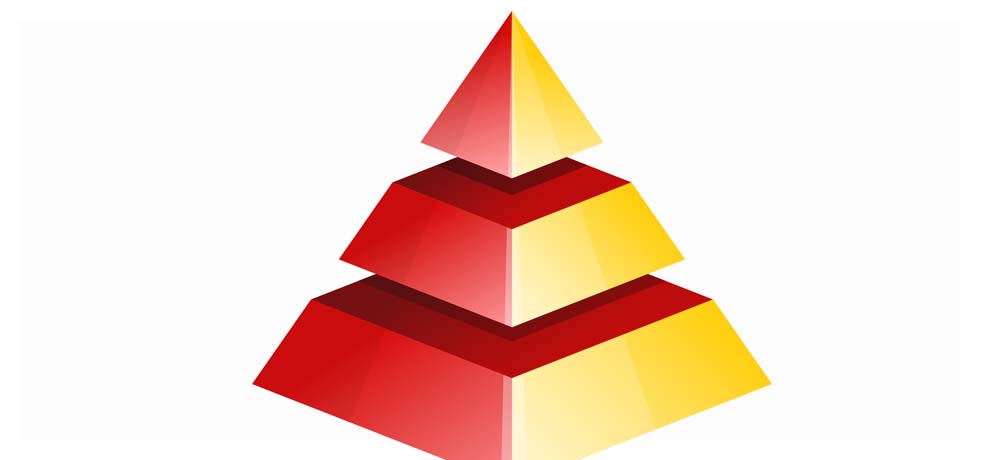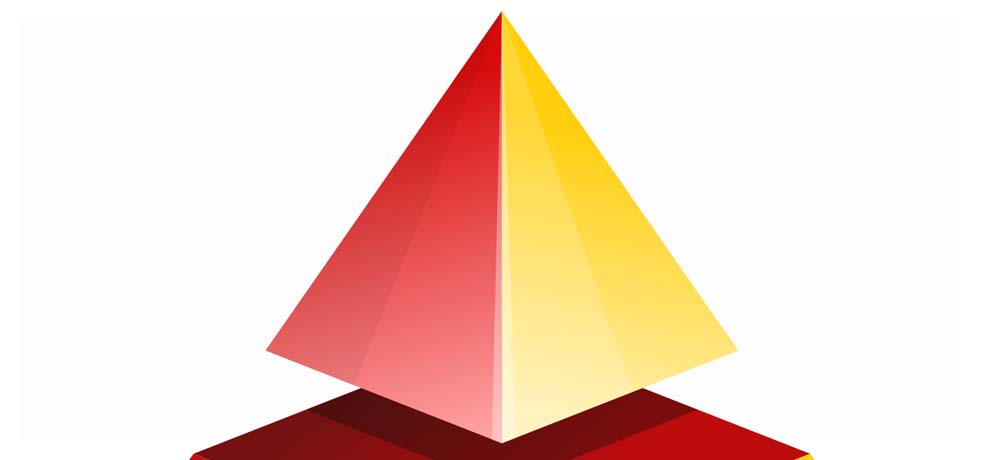When it comes to measuring the health and performance of your supply chain, quality—in terms of KPIs—is usually better than quantity, and a simple hierarchy of metrics comprising 17 KPIs is typically sufficient for any company to assess supply chain performance, conduct initial problem-diagnosis, and even drill down to the root causes.
In this post, we’ll explore this hierarchy of metrics (development of which is credited to AMR Research, a firm later purchased by Gartner) and the 17 interrelated KPIs that make up its three tiers of performance evaluation.
First… Picture a Pyramid
The hierarchy of metrics is graphically represented as a simple pyramid, split into three tiers. The top tier consists of three KPIs, making up the triangle at the pyramid’s apex.
This tier is called “assess”, because the three KPIs enable executives to quickly evaluate the overall state of supply chain health, and to see the tradeoffs involved in the execution of strategy.
The second tier, which makes up the central body of the pyramid between base and apex, is called “diagnose” and consists of another three KPIs, which together provide a mid-level view of supply chain performance, focusing predominantly on cash-flow.
The third, final, and largest tier is made up of two rows of KPIs which form the base of the pyramid. These 11 KPIs are all concerned with operational effectiveness and supplier performance. This bottom tier of the pyramid is called “correct”, because each of its 11 metrics can be used to identify and execute remedial interventions for issues highlighted by KPIs in the top two tiers.
Having looked briefly at the structure of the hierarchy of metrics, let’s move on to examine each of the three tiers in a little more detail.
The Pointy End of the Pyramid
The three supply chain KPIs at the top of the hierarchy of metrics are as follows:
- Demand forecast accuracy (DFA)
- Perfect order fulfillment
- Supply chain management cost
If you still have that pyramid in your mind’s eye, DFA is the KPI at the apex, with the perfect order and cost metrics sitting below the DFA. As mentioned in the previous section of this post, these are executive-level KPIs, and they are interrelated in a way that makes it easy to assess the overall health of the supply chain.
The demand forecast accuracy metric provides a predictive view of supply chain responsiveness. When forecasting accuracy is poor, responsiveness is likely to suffer, or at best, be costly to sustain.
That’s why we combine the other two measurements with DFA at the top of the hierarchy of metrics. If DFA is a leading indicator of responsiveness, then perfect order is its lagging counterpart. Meanwhile, supply chain management cost monitoring can alert leaders to financial excesses, which often arise when supply chains strive to achieve responsiveness in spite of poor demand visibility.
The Bit in the Middle
Below the apex of the pyramid lies a row of three KPIs used for high-level supply chain diagnostics. These KPIs make up the middle tier of the hierarchy of metrics. They are primarily focused on monitoring the supply chain cash-to-cash cycle (the process which begins with payment to suppliers and ends with the receipt of payments from customers) and comprise:
- Total inventory
- Days payables outstanding (DPO)
- Days sales outstanding (DSO)
As an example of how these KPIs combine to enable a basic degree of problem diagnosis, consider the two cash-to-cash metrics, DPO and DSO.
If the value of the latter metric exceeds that of the former, opportunities almost certainly exist to improve supply chain cash-flow. Furthermore, if the DSO figure is high, this might be a symptom of poor customer satisfaction, perhaps reflected in disputes over invoices or deliberate withholding of payments by customers.
Meanwhile, the total inventory metric offers more clues about the state of the supply chain. Excess inventory for instance, might corroborate evidence presented by the three first-tier KPIs.
Imagine an example in which perfect order fulfillment is good, supply chain management costs are high, and demand forecast accuracy is low. Taken together, these results might indicate that the company is accepting high inventories (and associated costs) in order to mitigate the risks of poor demand forecasting.
The Broad Base of the Pyramid
Now we come to the largest portion of the pyramid, which also happens to be the lowest level in the hierarchy of metrics. A total of eleven KPIs (a bottom row of six, and a row of five above) monitor performance of suppliers along with elements of the internal supply chain operation.
In most cases, this bottom tier of the hierarchy is made up of the following KPIs:
- Supplier Quality: The percentage of purchase orders that were received from suppliers in accordance with quality standards.
- Supplier On-time: The percentage of purchase orders that were received on time (as defined by criteria agreed between supplying and receiving parties).
- Raw Material Inventory: Usually measured as “raw material days in inventory”.
- Purchasing Operating Costs: This KPI measures the costs associated with purchasing processes. This would include factors such as labour and transactional costs.
- Direct Material Costs: This is an important KPI for manufacturing/production companies and measures the costs of raw materials used to create a product. This KPI is interrelated with supplier performance. For example, the cost of raw materials may increase if a supplier feels the need to charge more in order to meet certain quality or service demands from the customer.
- Supply Chain Management (SCM) Costs: This will typically be a much more detailed measurement of SCM costs than the first-tier KPI of the same name. If the high-level SCM cost KPI shows a poor level of performance, this metric may provide indications of exactly where cost-reduction efforts should be focused.
- Perfect Order: Again, this KPI breaks down the high-level perfect order KPI, enabling closer investigation into root causes of performance shortfalls.
- Finished Goods Inventory: This measurement, like the raw material inventory metric, feeds into the total inventory KPI in the second tier of the hierarchy of metrics.
- Work in Progress Inventory: This is a similar KPI to the finished goods and raw materials inventory, but shows unfinished goods which may exist anywhere in the supply chain.
- Plant Utilisation: This metric records the percentage of plant capacity that is in use and helps to provide a picture of production and/or storage efficiency.
The 11th of these “corrective” metrics can vary from operation to operation. Some companies for example, might measure the cycle-time for new product development, while another might choose to monitor adherence to the production schedule.
In fact, none of the KPIs in this bottom tier are set in stone. Those described here are simply the ones most commonly used for analysing supply chain performance and identifying problems at a granular level.
Hierarchy of Metrics: The Benefits
There are at least a couple of important benefits to using a hierarchy of metrics similar to the one described in this post. For one thing, it can help curb a common tendency to put too many KPIs in place.
The 17 interrelated metrics contained in the hierarchy are more than sufficient for most organisations to:
- Keep tabs on how the supply chain is performing generally
- Quickly ascertain when specific operational areas need improvement
- Identify why these areas are underperforming, and where to concentrate remedial efforts.
Another benefit of the hierarchy of metrics is its popularity. Because many companies use the hierarchy, it makes an ideal basis for benchmarking your own supply chain against those of other organisations, whether they are competitors, industry peers, or companies in other industries with similar supply chain dynamics.
Build Your Own KPI Pyramid

If your company is finding KPIs a challenge (as many organisations do), why not take a look at how the hierarchy of metrics could be adapted to suit your supply chain?
It’s not essential to follow the above guidance to the letter, so feel free to substitute some of the KPIs with measurements you feel are more suited to your supply chain environment. The important thing is to remember the principle of a tiered approach to supply chain performance measurement.
Start with two or three high-level KPIs for the executives, support those with a second tier for basic diagnosis, and maintain a base of detailed metrics concentrating on internal processes and supplier performance.
Please also remember that whether you wish to use the hierarchy of metrics or not, Benchmarking Success is here to help you with supply chain KPI development.
If you’d like to know more about our range of benchmarking and KPI services, just drop us a line using our website contact form. We’ll respond within 24 hours, either to provide the answers or arrange for a team member to speak with you by phone.


Hi,
I am Piet Verbakel and I am responsible for Forecasting & Replenishment in Dutch Retail Company Jumbo (no 2 in market). I have only recently joined this company and one of the big focus areas for improvement I see is in KPI alignment which is why I was searching the web and got to your pyramid concept. I think this is a great model to work with the team on filling the pyramid for our specific situation. If you have any addtional interesting material on this then I would appreciate your guidance here.
Another topic I am interested in is how the KPI alignment would work beyond the Supply Chain function with other functions. Ideally a company would have a clear view on the overall top of the pyramid KPI’s (e.g. turnover, margin, market share growth) and then understand the underlying KPI’s influencing this. Do you have materialm on that?
Regards
Piet Verbakel
We have a lot on our YouTube Channel here: https://www.youtube.com/c/robobyrne